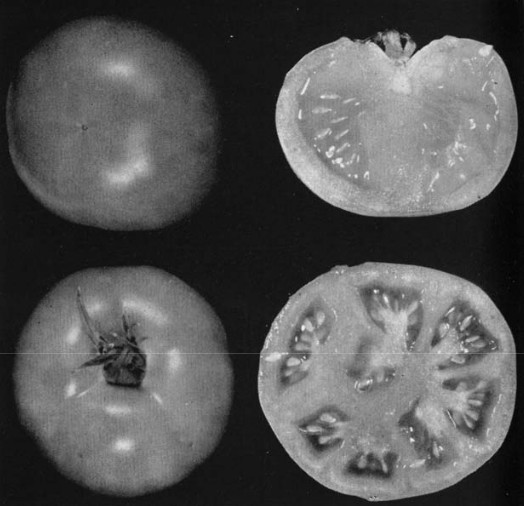 Variété
précédente Variété suivante
Variété
précédente Variété suivante
 Variété
précédente Variété suivante
Variété
précédente Variété suivante
Retour à la page "Passion tomate"
mise à jour le : 11-05-2020
Blair Forcing OP
Variété citée en 1936 dans l'étude "New Wilt-Resistant Tomato varieties for field and greenhouse
Auteur :W. A. Huelsen de l'Université de l'Illinois. College of Agriculture. Agricultural experiment station and service in agriculture and home economic.
Croisement de "Louisiana Pink" et de "Grand Rapids Forcing" présenté en 1930
Origin. A cross between Louisiana Pink and Grand
Rapids Forcing, introduced in 1930, described in Illinois Station Bulletin 361.
Selection has been continued to the fifteenth generation, but without any
particular success in changing or improving the type. Vine type. Very rapid and
vigorous in growth; reaches the usual topping height of 9 feet two or three
weeks sooner than Bonny Best or Marglobe. Blooms very freely and sets an average
of 3.4 mature fruits per cluster in the fall without hand pollination; daily
shaking of the vines is all that is required. Averages 5.6 mature fruits per
cluster consistently in the spring. Foliage is medium green. Fruits. Pink,
smooth, flattened, with five or more small seed cells usually arranged in
irregular order. Small core, rind medium in thickness, and fruit very solid and
usually free from the puffiness which characterizes many varieties. The flavor
is tart and pleasant. Blair Forcing is a free seeder. The blossom scar is small
and basin at stem end shallow. The flesh is deep red and the fruit is excellent
for slicing. In adverse seasons the fruits on some clusters may become rough,
but the set is heavy enough to permit thinning these out at a very early stage.
Yields. Yields of Blair Forcing are much superior to those of Bonny Best and
Marglobe and only a little less than yields of Lloyd Forcing (see table, page
20). The fruits are somewhat smaller than Lloyd Forcing. Use. Blair Forcing is a
pink tomato adapted for either fall or spring production. The fruits are
somewhat small but very solid and excellent for salad purposes. The variety
matures about 10 percent more of its crop than l\1arglobe during the first month
of picking in the fall and 20 percent more in the spring.
[